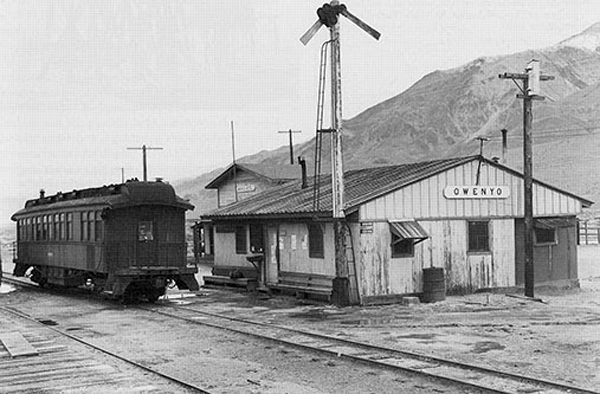Owenyo, CA

Photo - OwensValleyHistory.com
Owenyo’s story makes more sense when you see it as part of a much bigger railroad picture. It was never meant to stand alone. It was a piece in the puzzle of how the Owens Valley connected to the outside world, caught between an old narrow-gauge line that wandered the desert and a new standard-gauge branch that pulled it into the wider Southern Pacific system.
The narrow-gauge came first. The Carson & Colorado Railroad was built in the 1880s to reach remote mining camps and settlements along the eastern Sierra. It was a shoestring line, built light and cheap, with rails barely three feet apart. By 1900, Southern Pacific had taken it over, but it still struggled to earn its keep. When the company decided to push a standard-gauge line north from Mojave into Owens Valley, it needed a meeting point between the old and the new. That meeting point became Owenyo.
In 1908, the Jawbone Branch reached Owenyo. From that moment on, the little town was the gateway. Narrow-gauge cars from the north rolled in from Keeler, while standard-gauge cars arrived from the south. Owenyo was where the loads were shifted: bags of produce, ore, timber, livestock, barrels of fuel. For half a century, this transfer gave Owenyo life. It was dusty, noisy, and hard work, but it tied the valley to markets far beyond the Sierra.
Owenyo’s role faded as trucks took over in the 1950s. Highways could carry goods faster and more directly, without the awkward dance of transferring loads between mismatched rails. By 1960, when Southern Pacific finally abandoned the narrow-gauge line to Keeler, Owenyo’s reason for being was gone. The Jawbone Branch itself lingered, mainly serving the aqueduct project and later the Lone Pine area, but without the interchange, Owenyo was finished.
Today, Owenyo is just a memory in the desert, a reminder of how railroads once shaped whole towns and how quickly those towns could vanish when the rails moved on.
Timeline of Owenyo in the larger desert rail network:
1880s – Carson & Colorado narrow-gauge built, running south into Owens Valley.
1905 – Owenyo founded as the designated transfer point for freight, northeast of Lone Pine.
1908 – Southern Pacific’s Jawbone Branch (standard gauge) completed from Mojave to Owenyo, linking the valley to the main rail system.
1910s–1940s – Owenyo thrives as the interchange hub between narrow and standard gauge.
1950s – Trucking grows; freight bypasses the rail transfer at Owenyo.
1960 – Narrow-gauge from Owenyo to Keeler abandoned, ending Owenyo’s purpose.
Post-1960 – Owenyo abandoned; only foundations and rail remnants remain.